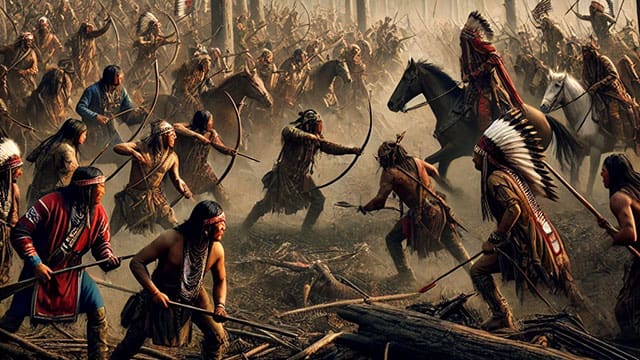Colonialism is not just a European concept. Indigenous groups practiced it, too
When we think about colonialism, we often picture European powers arriving in the New World, taking over Indigenous lands, and imposing their rule. But the idea of one group seizing the territory of another isn’t just a European invention. Long before European ships landed in North America, Indigenous groups in Canada were expanding, displacing others, and exerting control over new territories in their own ways.
 Take the Haudenosaunee Confederacy, also known as the Iroquois. In the 1600s, they were involved in a series of conflicts known as the Beaver Wars. Their goal? To dominate fur trade routes and hunting grounds. To achieve this, they pushed out other Indigenous nations like the Huron-Wendat, Petun, and Erie. Entire communities were forced to leave their homelands, and those who were captured didn’t just get a pass – many were enslaved or assimilated into Haudenosaunee society. This kind of expansion wasn’t so different from what Europeans did, but it was happening right here in North America long before European colonizers showed up.
Take the Haudenosaunee Confederacy, also known as the Iroquois. In the 1600s, they were involved in a series of conflicts known as the Beaver Wars. Their goal? To dominate fur trade routes and hunting grounds. To achieve this, they pushed out other Indigenous nations like the Huron-Wendat, Petun, and Erie. Entire communities were forced to leave their homelands, and those who were captured didn’t just get a pass – many were enslaved or assimilated into Haudenosaunee society. This kind of expansion wasn’t so different from what Europeans did, but it was happening right here in North America long before European colonizers showed up.
| Our Views |
| Why Human Rights Commissions need a new name and focus
|
| Canada needs a Department of Unintended Consequences
|
| The unsettling reality of fascism across the political spectrum
|
Further north, we see a similar story between the Cree and the Dene. As the Cree gained access to firearms through European trade, they used this new advantage to push northward, displacing the Dene in the process. But it wasn’t just about taking land; it was also about controlling resources like fur. The Cree didn’t just stop at winning battles – they captured Dene people and forced them into slavery, much like what we associate with European colonization.
On the Great Plains, the Blackfoot Confederacy was doing something similar. Equipped with horses and guns, they expanded their territory, displacing groups like the Shoshone. And the violence wasn’t limited to just battles – villages were sometimes wiped out, and survivors were taken as slaves or absorbed into the Blackfoot society. This kind of brutal expansion echoes the massacres we often associate with European colonization.
Up in the Arctic, the Inuit gradually displaced the Tuniit (Dorset) people from their hunting grounds. While not a swift or violent takeover over time, the Tuniit culture disappeared as the Inuit claimed their territory. It’s another reminder that territorial expansion wasn’t unique to Europeans.
And in British Columbia, the Kwakwaka’wakw expanded their influence through raids on neighbouring groups like the Nuu-chah-nulth. These raids weren’t just about grabbing resources – they often resulted in the capture of slaves. Many of the captured were women and children, and they became part of the Kwakwaka’wakw society, serving the chiefs. Again, not so different from how European colonial economies relied on forced labour.
These examples make one thing clear: colonialism wasn’t a foreign concept to the Indigenous peoples of Canada. They, too, practiced forms of expansion, displacement, and control, whether through warfare, forced assimilation, or slavery. It’s a part of history that complicates the simple narrative of Europeans arriving and taking over.
Indigenous groups were not merely passive recipients of external forces: they were actively shaping their world long before Europeans stepped onto their land.
© Troy Media
Troy Media is an editorial content provider to media outlets and its own hosted community news outlets across Canada.


